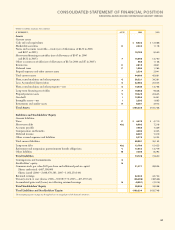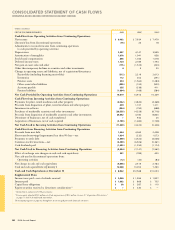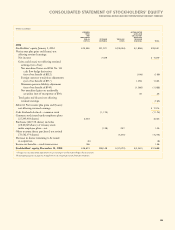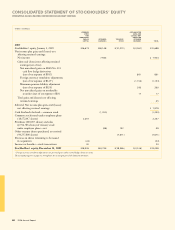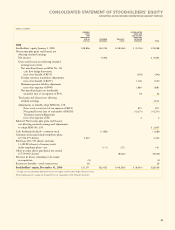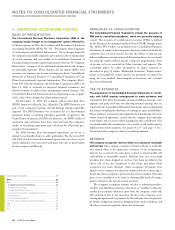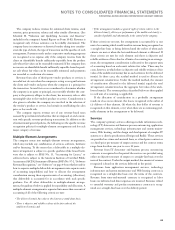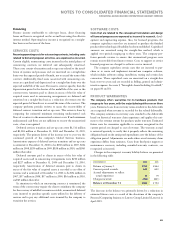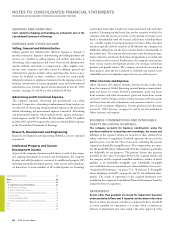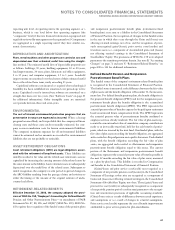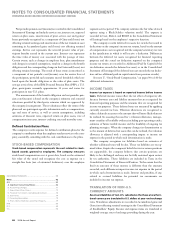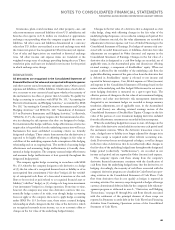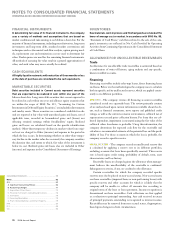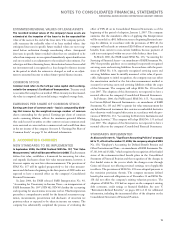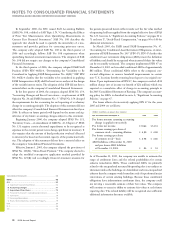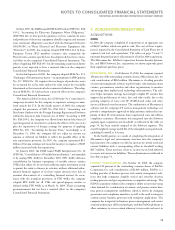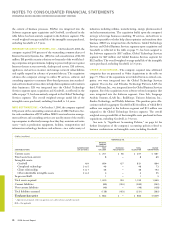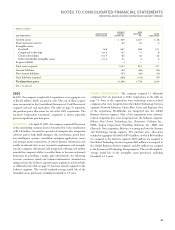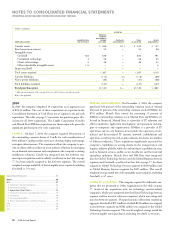IBM 2006 Annual Report Download - page 69
Download and view the complete annual report
Please find page 69 of the 2006 IBM annual report below. You can navigate through the pages in the report by either clicking on the pages listed below, or by using the keyword search tool below to find specific information within the annual report.Black
MAC
CG10
reporting unit level. A reporting unit is the operating segment, or a
business, which is one level below that operating segment (the
“component” level) if discrete financial information is prepared and
regularly reviewed by management at the segment level. Components
are aggregated as a single reporting unit if they have similar eco-
nomic characteristics.
DEPRECIATION AND AMORTIZATION
Plant, rental machines and other property are carried at cost and
depreciated over their estimated useful lives using the straight-
line method. The estimated useful lives of depreciable properties are
as follows: buildings, 50 years; building equipment, 10 to 20 years;
land improvements, 20 years; plant, laboratory and office equipment,
2 to 15 years; and computer equipment, 1.5 to 5 years. Leasehold
improvements are amortized over the shorter of their estimated useful
lives or the related lease term, rarely exceeding 25 years.
Capitalized software costs incurred or acquired after technological
feasibility has been established are amortized over periods up to five
years. Capitalized costs for internal-use software are amortized on a
straight-line basis over two years. (See “Software Costs” on page 65
for additional information). Other intangible assets are amortized
over periods between three and seven years.
ENVIRONMENTAL
The cost of internal environmental protection programs that are
preventative in nature are expensed as incurred. When a cleanup
program becomes likely, and it is probable that the company will incur
cleanup costs and those costs can be reasonably estimated, the com-
pany accrues remediation costs for known environmental liabilities.
The company’s maximum exposure for all environmental liabilities
cannot be estimated and no amounts are recorded for environmental
liabilities that are not probable or estimable.
ASSET RETIREMENT OBLIGATIONS
Asset retirement obligations (ARO) are legal obligations associ-
ated with the retirement of long-lived assets. These liabilities are
initially recorded at fair value and the related asset retirement costs are
capitalized by increasing the carrying amount of the related assets by
the same amount as the liability. Asset retirement costs are subsequently
depreciated over the useful lives of the related assets. Subsequent to
initial recognition, the company records period-to-period changes in
the ARO liability resulting from the passage of time and revisions to
either the timing or the amount of the original estimate of undis-
counted cash flows.
RETIREMENT-RELATED BENEFITS
Effective December 31, 2006, the company adopted the provi-
sions of SFAS No. 158, “Employer’s Accounting for Defined Benefit
Pension and Other Postretirement Plans—an amendment of FASB
Statements No. 87, 88, 106, and 132(R)” (SFAS No. 158). SFAS No.
158 requires the recognition of the funded status of the pension plans
and nonpension postretirement benefit plans (retirement-related
benefit plans) as an asset or a liability in the Consolidated Statement
of Financial Position, the recognition of changes in that funded status
in the year in which they occur through the Gains and (losses) not
affecting retained earnings, net of tax, and the recognition of previ-
ously unrecognized gains/(losses), prior service costs/(credits) and
transition assets as a component of Accumulated gains and (losses)
not affecting retained earnings in the Consolidated Statement of
Stockholders’ Equity. The provisions of SFAS No. 158 were adopted
pursuant to the transition provisions therein. See note B, “Accounting
Changes” on page 71 and note V, “Retirement-Related Benefits,” on
pages 100 to 111 for additional information.
Defined Benefit Pension and Nonpension
Postretirement Benefit Plans
The funded status of the company’s retirement-related benefit plans
is recognized in the Consolidated Statement of Financial Position.
The funded status is measured as the difference between the fair value
of plan assets and the benefit obligation at December 31, the measure-
ment date. For defined benefit pension plans, the benefit obligation is
the projected benefit obligation (PBO) and for the nonpension post-
retirement benefit plans the benefit obligation is the accumulated
postretirement benefit obligation (APBO). The PBO represents the
actuarial present value of benefits expected to be paid upon retirement
based on estimated future compensation levels. The APBO represents
the actuarial present value of postretirement benefits attributed to
employee services already rendered. The fair value of plan assets rep-
resents the current market value of cumulative company contributions
made to an irrevocable trust fund, held for the sole benefit of partici-
pants, which are invested by the trust fund. Overfunded plans, with the
fair value of plan assets exceeding the benefit obligation, are aggregated
and recorded as a Prepaid pension asset equal to this excess. Underfunded
plans, with the benefit obligation exceeding the fair value of plan
assets, are aggregated and recorded as a Retirement and nonpension
postretirement benefit obligation equal to this excess. The current
portion of the Retirement and nonpension postretirement benefit
obligations represent the actuarial present value of benefits payable in
the next 12 months exceeding the fair value of plan assets, measured
on a plan-by-plan basis. This liability is recorded in Compensation
and benefits in the Consolidated Statement of Financial Position.
(Gains)/losses and prior service cost/(credit) not recognized as a
component of net periodic pension cost/(income) in the Consolidated
Statement of Earnings as they arise are recognized as a component of
Gains and (losses) not affecting retained earnings in the Consolidated
Statement of Stockholders’ Equity, net of tax. Those (gains)/losses and
prior service cost/(credit) are subsequently recognized as a component
of net periodic pension period cost/(income) pursuant to the recogni-
tion and amortization provisions of applicable accounting standards.
(Gains)/losses arise as a result of differences between actual experience
and assumptions or as a result of changes in actuarial assumptions.
Prior service cost/(credit) represents the cost of benefit improvements
attributable to prior service granted in plan amendments.
NOTES TO CONSOLIDATED FINANCIAL STATEMENTS
INTERNATIONAL BUSINESS MACHINES CORPORATION AND SUBSIDIARY COMPANIES
67


